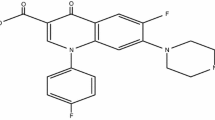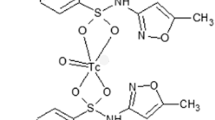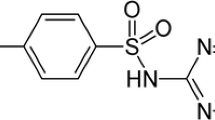Abstract
In the current investigation the complexation of derivatized temafloxacin with 99mTc using [99mTc(CO)3(H2O)3]+ precursor was assessed. The tricarbonyl complex of the temafloxacin dithiocarbamate (99mTc(CO)3-TAND) was characterized in terms of radiochemical purity (RCP) yield in saline, in vitro radiochemical stability in serum, in vitro binding with Streptococci pneumoniae and biodistribution in male Wister rats (MWR) artificially infected with living and heat killed Streptococci pneumoniae. The 99mTc(CO)3-TAND complex showed 98.10 ± 15% RCP value at 30 min of the reconstitution and remained more than 90% stable up to 120 min in normal saline at room temperature. In serum a stable behavior with the appearance of 15.30% unwanted side product up to 16 h of incubation was observed. A saturated in vitro binding with Streptococci pneumoniae was observed. The complex showed almost six times higher uptake in the infected muscle as compared to the inflamed and normal muscles of the MWR infected with living Streptococci pneumoniae. Insignificant difference in the uptake of the tracer in the infected, inflamed and normal muscles of the MWR infected with heat killed Streptococci pneumoniae was noted. Based on the elevated RCP in saline, in vitro stability in serum at 37 °C, saturated in vitro binding with pathogens and better biodistribution behavior with higher accumulation of the tracer in target organs confirmed the suitability of the 99mTc(CO)3-TAND complex as promising infection radiotracer.
Similar content being viewed by others
Avoid common mistakes on your manuscript.
Introduction
Technetium-99m (99mTc) labeled quinolones are nowadays frequently used to identify deep soft tissue infection for accurate in time decision and management [1, 2]. Recently, the reported 99mTc-labeled bioactive molecules have revealed high radiochemical yield, in vitro permanence in serum, in vitro binding with bacteria, soaring target to non target ratio and precise scintigraphic localization of infectious foci [3–24].
Temafloxacin (TAN) (Fig. 1a) [1-(2,4-Difluorophenyl)-6-fluoro-7-(3-methylpiperazin-1-yl)-4-oxoquinoline-3-carboxylic] is another broad-spectrum fluorinated quinolone showing advantageous in vivo and in vitro pharmacokinetics. TAN akin to other quinolones has proven potent against respiratory pathogens including Staphylococcus aureus, Moraxella catarrhalis, Haemophilus influenzae, Legionella pneumophila and Klebsiella pneumoniae. It is reported that TAN, has revealed almost eight fold in vivo higher potency against Streptococci pneumoniae and Streptococcus pyogenes [25, 26].
To make use of the higher activity of TAN, to diagnosis of infection caused by Streptococci pneumoniae, in the present investigation, TAN was devitalized to temafloxacin dithiocarbamate (TAND) and radiolabeled with technetium-99m (99mTc) using the [99mTc(CO)3(H2O)3]+ precursor. The 99mTc- tricarbonyl temafloxacin dithiocarbamate (99mTc(CO)3-TAND) complex was radiochemically and biologically characterized in terms of radiochemical stability in normal saline, in vitro permanence in serum, in vitro binding with Streptococci pneumoniae and biodistribution in Wister male rats (WMR) artificially infected by Streptococci pneumoniae.
Experimental
Materials
Temafloxacin (TAN) (Shanghai Sciencya Biotechnology Co., Ltd. Shanghai, China), TLC (Merck) and all the other chemicals and solvents of analytical grade (Sigma). RP-HPLC (Shimadzu, Japan) well counter and scalar count rate meter (Ludlum, USA) Dose calibrator (Capintech, USA) and Gamma camera GKS-1000 (GEADE Nuclearmedizine system, Germany).
Method
Tricarbonyl radiocomplexation of temafloxacin dithiocarbamate
Temafloxacin (TAN) was derivatized to temafloxacin dithiocarbamate (TAND) using the reported method [22] by mixing equal amount of TAN, tetrahydrofuran (THF) and carbon disulfide (CS2) in the presence of sodium hydroxide. Then 74 MBq (0.5 mL) of sodium pertechnetate (Na99mTcO4 −) and 0.1 mol/mL HCL solution to the Isolink kit and incubated for 15 min at room temperature. Thereafter, 2 mg of the TAND was added to the Isolink kit and incubated the reaction mixture for 15 min.
Partition coefficient (P)
In equal amount the freshly prepared 99mTc(CO)3-TAND complex, octanol and phosphate buffer (PB) was vortexed for 5 min followed by centrifugation at 5000 rpm/min for 10 min. Thereafter, 0.1 mL of the reaction mixture was taken at different intervals and measured in the in well counter interface with scalar count rate meter (WCCRM) using the equation. P = CPM in octanol − CPM in background/CPM in buffer − CPM in background.
Radiochemical characterization
The 99mTc(CO)3-TAND complex was radiochemically characterized in saline using the HPLC method reported earlier [22]. Briefly, to the Shimadzu HPLC unit interface with UV detector (working at 254 nm), flow scintillation analyzer, binary pump an online degasser and C-18 (4.6 × 150 mm) column, 5 μL of the 99mTc(CO)3-TAND complex was injected. 1 mL/min elution was allowed for 20 min using water:methanol (W:M) 0–3 min (100:00), 3–7 min (60:40), 7–10 min (55:45), 10–13 (25:75), 13–16 (00:100) and 16–20 (50:50) as the mobile phase. The radio-eluents collected during 15 min of the process were counted for activity using WCCRM.
Stability in serum
The stability of the 99mTc(CO)3-TAND complex in serum was determined by using the thin layer chromatography. 0.2 mL of the 99mTc(CO)3-TAND complex was incubated at 37 °C with 1.8 mL of serum for 16 h. Aliquots at 0, 2, 4, 6, 8, 10, 12, 14 and 16 h during incubation were taken and spotted on the TLC strips. The strips were then developed for separation of various component of the complex in saline and CH2Cl2:CH3OH (9:1) (v/v). After development the radiostrips were divided into two parts and measured for activity in each part using WCCRM.
In vitro binding with Streptococci pneumoniae
In vitro binding capability of the 99mTc(CO)3-TAND complex was investigated using the reported method [27]. Briefly, 0.1 mL of the sodium phosphate buffer (Na-PB) was mixed with 10 MBq of the 99mTc(CO)3-TAND complex in clean and pyrogen free test tube. Thereafter, 0.8 mL (50%, v/v) 0.01 M acetic acid containing approximately 1 × 108 colony forming units (CFU) of Streptococci pneumoniae was added followed by incubation at 4 °C for 1 h and the pH was adjusted to 5. The reaction mixture was then centrifuged at 2000 rpm for 10 min. After that the supernatant was removed and the bacterial pellets were resuspended in 2 mL Na-BP. The reaction mixture was re-centrifuged at 2000 rpm/min for another 10 min. Next, the bacterial pellets were measured for percent in vitro uptake in WCCRM.
Biodistribution in MWR
The in vivo (percent per gram) accumulation of the 99mTc(CO)3-TAND complex in blood, liver, spleen, stomach, intestine, kidney, infected muscle, inflamed and normal muscle of the MWR artificially infected with living and heat killed Streptococci pneumoniae was studied. Sixteen healthy MWR (weight, 160–180 g) were selected and alienated into two groups (A and B) each having eight MWR. All the MWR were intramuscularly injected 0.2 mL sterile turpentine oil into their left thigh. Thereafter, 0.2 mL of the living Streptococci pneumoniae was injected I.M. to the left of the MWR of group A and heat killed to the group B. 24 h, after 0.2 mL of the freshly prepared 99mTc(CO)3-TAND radiotracer was intravenously (I.V.) injected to all the MWR. Next, all the MWR were sacrificed in accordance with the rules of the Nuclear Medicine Research Laboratory (NMRL), University of Peshawar (Part-I and II). Then in vivo (percent per gram) accumulation of the 99mTc(CO)3-TAND complex in blood, liver, spleen, stomach, intestine, kidney, infected muscle, inflamed and normal muscle of the MWR artificially infected with living and heat killed Streptococci pneumoniae were calculated using WCCRM.
Results and discussion
Radiochemistry of the 99mTc(CO)3-TAND complex
Temafloxacin (TAN) a bidentate chelator as shown in Fig. 1a was derivatized to tetradentate temafloxacin dithiocarbamate (TAND) as shown in Fig. 1b for much stronger and stable complexation with 99mTc using the [99mTc(CO)3(H2O)3]+ precursor. The tetradentate TAND under substitution reaction easily replaced the H2O from the [99mTc(CO)3(H2O)3]+ precursor and gave a stable 99mTc-tricarnoly temafloxacin dithiocarbamate complex as shown in Fig. 1c. The proposed radiochemical arrangement of the 99mTc(CO)3-TAND complex will have a square planner bipyramidal geometry with 99mTc(CO)3:TAND ratio of 2:1 [28].
The HPLC radiochromatogram of the 99mTc(CO)3-TAND complex showed two radiopeaks at 4.1 and 14.4 min of retention as shown in Fig. 2. The radiopeak observed at 14.4 min of retention correspond to the radiochemical yield of the 99mTc(CO)3-TAND complex.
The 99mTc(CO)3-TAND complex behave normally and stable in normal saline at room temperature. The radiochemical stability of the 99mTc(CO)3-TAND complex at 30, 60, 90, 120 and 240 min of reconstitution in given in Fig. 3. The highest radiochemical stability value observed was 98.10 ± 0.15% recorded at 30 min after reconstitution. The value of the radiochemical stability went down from 98.10 ± 0.15% to 90.50 ± 0.18% within 240 min.
Lipophilicity of the 99mTc(CO)3-TAND complex
The participation coefficient (P) value of the 99mTc(CO)3-TAND complex was 0.44 ± 0.01 signifying lipophilicity.
Stability in serum
In vitro stability profile of the 99mTc(CO)3-TAND complex is given in Fig. 4. It was observed that the 99mTc(CO)3-TAND complex was remained more than 90% stable up to 4 h under incubation. The stability value decreased by 15.30% due the formation of undesirable side product within 16 h
In vitro binding with Streptococci pneumoniae
Streptococci pneumoniae showed in vitro saturated binding with the 99mTc(CO)3-TAND complex at different intervals with a maximum value of 77.00% at 90 min. The in vitro binding affinity of the Streptococci pneumoniae with the 99mTc(CO)3-TAND complex is given in Fig. 5.
Biodistribution in MWR
The in vivo (percent) accumulation of the 99mTc(CO)3-TAND complex in (per gram) blood, liver, spleen, stomach, intestine, kidney, infected muscle, inflamed and normal muscle of the MWR of group A and B is given in Table 1. In the beginning of I.V injection of the 99mTc(CO)3-TAND complex to the MWR of group A and B, high level of activity was observed which went down to 19.20 ± 0.14% from 4.00 ± 0.16% with 120 min. Similarly, the level of radioactivity in per gram of the liver, spleen, stomach and intestines was decreased from 14.50 ± 0.18% to 4.50 ± 0.00%, 8.50 ± 0.14% to 4.00 ± 0.14% and 7.80 ± 0.14% to 3.85 ± 0.18% respectively within 120 min of the I.V injection of the complex. However, an opposite behavior was seen in kidneys wherein the activity goes up with time from 8.25 ± 0.18% to 23.10 ± 0.19% within 120 min. Insignificant marginal variation in the uptake values in liver, spleen, stomach, intestines and kidneys. Six times higher accumulation of the radiotracer was seen in the infected muscle than inflamed and normal muscles of the MWR of group A. However, no difference in the percent accumulation of the radiotracer in the infected, inflamed and normal muscles of the MWR of the group B was noted. The uptake ratios of the radiotracer in the infected muscles of the MWR of the group A and B are illustrated Fig. 6. In the urinary system the appearance of the activity of the 99mTc(CO)3-TAND radiotracer and disappearance from the circulatory system confirmed the normal path for excretion from the MWR of group A and B.
Conclusion
99mTc-tricarbonyl complexation of the temafloxacin dithiocarbamate was investigated in terms of RCP yield in saline, in vitro radiochemical stability in serum, in vitro binding with Streptococci pneumoniae and biodistribution in male Wister rats (MWR) artificially infected with living and heat killed Streptococci pneumoniae. The elevated RCP values in saline, in vitro stability in serum at 37 °C, saturated in vitro binding with Streptococci pneumoniae and better biodistribution behavior with higher accumulation of the complex in target organ confirmed the feasibility of the 99mTc(CO)3-TAND complex as potential in vivo infection radiotracer.
References
Gallagher H, Ramsay SC, Barnes J, Maggs J, Cassidy N, Ketheesan N (2006) Neutrophil labeling with [99mTc]-technetium stannous colloid is complement receptor 3-mediated and increases the neutrophil priming response to lipopolysaccharide. Nucl Med Biol 33:433
Basu S, Chryssikos T, Moghadam-Kia S, Zhuang H, Torigian DA, Alvai A (2009) Positron emission tomography as a diagnostic tool in infection: present role and future possibilities. Semin Nucl Med 39:36
Chattopadhyay S, Das SS, Chandra S, De K, Mishra M, Sarkar BR, Sinha S, Ganguly S (2010) Synthesis and evaluation of 99mTc-moxifloxacin, a potential infection specific imaging agent. Appl Radiat Isot 68:314
Motaleb MA (2007) Preparation of 99mTc-cefoperazone complex, a novel agent for detecting sites of infection. J Radioanal Nucl Chem 272:167
Motaleb MA (2007) Preparation and biodistribution of 99mTc-lomefloxacin and 99mTc-olfloxacin complex. J Radioanal Nucl Chem 272:95
Zhang J, Guo H, Zhang S, Lin Y, Wang X (2008) Synthesis and biodistribution of a novel 99mTcN complex of ciprofloxacin dithiocarbamate as a potential agent for infection imaging. Bioorg Med Chem Lett 18:51
Roohi S, Mushtaq A, Jehangir M, Ashfaq MS (2006) Synthesis, quality control and biodistribution of 99mTc-Kanamycin. J Radioanal Nucl Chem 267:561
Oh SJ, Ryu J, Shin JW, Yoon EJ, Ha H, Cheon JH, Lee HK (2002) Synthesis of 99mTc-ciprofloxacin by different methods and its biodistribution. Appl Radiat Isot 57:193
EL-Gany EA, EL-Kolaly MT, Amine AM, EL-Sayed AS, Abdel-Gelil F (2005) Synthesis of 99mTc-pefloxacin: a new targeting agent for infectious foci. J Radioanal Nucl Chem 266:131
Motaleb MA (2009) Preparation, quality control and stability of 99mTc-sparafloxacin complex, a novel agent for detecting sites of infection. J Label Compd Radiopharm 52:415
Xia J, Wang Y, Yu J, Li S, Tang L, Zheng M, Liu X, Li G, Cheng D, Liang S, Yin D (2008) Synthesis, in vitro and in vivo behavior of 188Re(I)-tricarbonyl complexes for the future functionalization of biomolecules. J Radioanal Nucl Chem 275:325
Zhang J, Wang X, Jin C (2007) Synthesis and biodistribution of the 99mTc(CO)3-DEDT complex as a potential new radiopharmaceutical for brain imaging. J Radioanal Nucl Chem 272:91
Djokic DD, Jankovic DL, Stamenkovic LL, Pirmettis I (2004) Chemical and biological evaluation of 99mTc (CO)3 and 99mTc complexes of some IDA derivatives. J Radioanal Nucl Chem 260:471
Xia J, Long S, Yu J, Wang Y, Cao Z (2009) Pyridyl derivatives provide new pathways for labeling protein with fac-[188Re(CO)3(H2O)3]+. J Radioanal Nucl Chem 281:493
Zhang JB, Wang XB, Jin C (2006) Synthesis of 99mTc(CO)3-NOET via [99mTc(OH2)3(CO)3]+ precursor and comparative biological studies with 99mTcN-NOET. J Radioanal Nucl Chem 269:227
Qaiser SS, Khan AU, Khan MR (2010) Synthesis, biodistribution and evaluation of 99mTc-Sitafloxacin kit: a novel infection imaging agent. J Radioanal Nucl Chem 284:189
Shah SQ, Khan AU, Khan MR (2010) Radiosynthesis of 99mTc-nitrifuratonin a novel radiotracer for in vivo imaging of Escherichia coli infection. J Radioanal Nucl Chem. doi:10.1007/s10967-010-0697-z
Shah SQ, Khan AU, Khan MR (2010) Radiosynthesis and biodistribution of 99mTc-rifampicin: a novel radiotracer for in vivo infection imaging. Appl Radiat Isot 68:2255
Shah SQ, Khan AU, Khan MR (2010) 99mTc-Novobiocin: a novel radiotracer for infection imaging. Radiochimica acta (in press)
Shah SQ, Khan AU, Khan MR (2010) Radiosynthesis, biodistribution and scintigraphy of the 99mTc-Teicoplanin complex in artificially infected animal models. J Label Compd Radiopharm. Online published on 4 November 2010
Shah SQ, Khan AU, Khan MR (2010) Radiosynthesis and biological evaluation of 99mTcN-sitafloxacin dithiocarbamate as potential radiotracer for Staphylococcus aureus infection. J Radioanal Nucl Chem. doi:10.1007/s10967-010-0833-9
Shah SQ, Khan AU, Khan MR (2010) Radiosynthesis and biological evolution of 99mTc(CO)3-sitafloxacin dithiocarbamate complex: a promising Staphylococcus aureus infection radiotracer. J Radioanal Nucl Chem. doi:10.1007/s10967-010-0880-2
Shah SQ, Khan MR (2010) Radiocomplexation and biological characterization of the 99mTcN-Trovafloxacin dithiocarbamate: a novel methicillin-resistant Staphylococcus aureus infection imaging agent. J Radioanal Nucl Chem. doi:10.1007/s10967-010-0903-z
Shah SQ, Khan MR (2010) Radiolabeling of gemifloxacin with technetium-99m and biological evaluation in artificially Streptococcus pneumoniae infected rats. J Radioanal Nucl Chem. doi:10.1007/s10967-010-0916-7
Segreti J (1991) In vitro activity of temafloxacin against pathogens causing sexually transmitted diseases. Am J Med 91:S24
Jacobs MR (1991) Evaluation of the bactericidal activity of temafloxacin. Am J Med 91:S31
Welling MM, Paulusma-Annema A, Batler HS, Pauwels EKJ, Nibbering PH (2000) Technetium-99m labelled antimicrobial peptides discriminate between bacterial infections and sterile inflammations. Eur J Nucl Med 27:292
Baldas J, Bonnyman J, Poer PM, Williams GA, Mackay MF (1981) Synthesis And Structure of bis(diethyldithiocarbamato)nitridotechnetium(V)—a technetium-nitrogen triple bond. J Chem Soc Dalton Trans 9:1798
Author information
Authors and Affiliations
Corresponding author
Rights and permissions
About this article
Cite this article
Shah, S.Q., Khan, M.R. Radiosynthesis and biodistribution of 99mTc-tricarbonyl complex of temafloxacin dithiocarbamate: a potential Streptococci pneumoniae infection radiotracer. J Radioanal Nucl Chem 288, 411–416 (2011). https://doi.org/10.1007/s10967-010-0936-3
Received:
Published:
Issue Date:
DOI: https://doi.org/10.1007/s10967-010-0936-3










